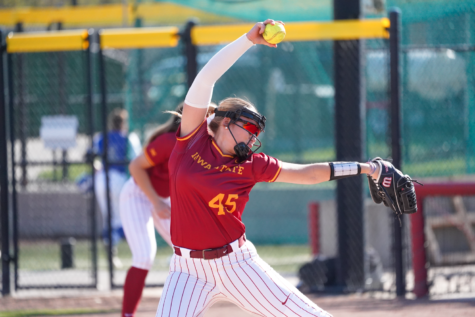Header plays vital role in soccer’s play
October 25, 2007
In most sports, using your head means being smart and strategic and outwitting an opponent. In soccer, however, it takes on a whole new meaning – derived from the technique of the header.
After seeing the ISU soccer team in action, it becomes evident that there is no shortage of players skilled in using the header.
“Ever since I was little, it has always been a constant of the game,” Cyclone midfielder Stephanie Kaphingst said of the art. “It makes a big difference in the midfield, especially when the ball is in the air. Everyone is skilled with their feet, but if you can get up in the air and win it before, you can redirect it to the open player before it ever comes down to anyone’s feet.”
Consistently referred to by coach Rebecca Hornbacher as a “dominant presence in the air” for the Cyclones, Kaphingst is known for her ability to go up with her head and win the ball at its highest point. At one point last season, she suffered a concussion while going for a header.
Hornbacher said that because of the significance of the aerial game, she routinely stresses the importance of the header.
“If you win headers, you have the opportunity to flick on a ball and keep possession and keep the ball going in the direction we want it to. It’s an area of the game you’re dominating in the air,” Hornbacher said. “Overall, it sends off a message of dominance and allows us to be able to help us offensively or stop them when they’re trying to use the long ball to their advantage.”
Some players said executing a header can sometimes be painful.
“If you hit it on the wrong side of your head it does [hurt],” Kaphingst said.
Sophomore midfielder Elise Reid agreed, especially when the ball is dropping from 40 to 50 yards in the air, such as on goal kicks and punts.
“Especially those ones that are on goal kicks; those hurt when you don’t hit them right,” Reid said.
Despite the pain, she said the ability to use a header is very important on both the offensive and defensive ends.
Because of the risks inherent in practicing headers, Hornbacher said she tries to limit the amount of practice her team spends on it because contact in the air can be dangerous.
“We work on it from time to time,” she said. “It’s not something you can work on on a daily basis, because there is so much impact with players and a possibility of injury.”
Defender Lauren Fader said she first learned the technique when she began playing club soccer, but the physical nature of the college game has changed her approach to the header.
“It’s always been an important part of the game but, getting older, when play starts to get more physical and everything, it kind of becomes more of an asset if you can really use that as a skill,” Fader said.
She added that, as a defender on the ISU back line, getting a head on the ball is often the best option.
“A lot of times, heading it is the only way you can get anything on it,” Fader said. “Defensively, it’s more important to get the ball up and out . you’re just trying to clear it out of the back.”
Although the header is prevalent throughout the range of age groups, Hornbacher said the level of competition can make a difference.
“It’s something that’s a factor even from young kids up,” Hornbacher said. “The difference between this level and younger kids is that they might not see as many crosses that are in the air as much as we do in the college game.”
















